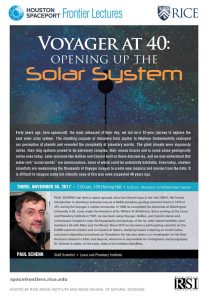November-30-2017
Voyager at 40: Opening up the solar system.
7:00pm
Keck Hall 100
Reception at 6:30pm – Valhalla Beer Garden
Paul Schenk – Staff Scientist, Lunar and Planetary Institute
ABSTRACT
Forty years ago, twin spacecraft, the most advanced of their day, set out on a 12-year journey to explore the vast outer solar system. The resulting cascade of discovery from Jupiter to Neptune fundamentally reshaped our perception of planets and revealed the complexity of planetary worlds. The giant planets were vigorously active, their ring systems proved to be extremely complex, their moons bizarre and in some cases geologically active even today. Later missions like Galileo and Cassini built on these discoveries, and we now understand that water-rich “ocean worlds” are commonplace, some of which could be potentially habitable. Even today, amateur scientists are reexamining the thousands of Voyager images to create new mosaics and movies from the data. It is difficult to imagine today but virtually none of this was even suspected 40 years ago.
BIOGRAPHY
PAUL SCHENK, PH.D., has been a space-groupie since the Gemini days in the mid 1960’s. His formal introduction to planetary sciences was as a NASA planetary geology summer intern in 1979 at JPL during the Voyager 2 Jupiter encounter. In 1988 he completed his doctorate at Washington University in St. Louis under the direction of Dr. William B. McKinnon. Since arriving at the Lunar and Planetary Institute in 1991, he has been using Voyager, Galileo, and Cassini stereo and monoscopic images to map the topography and geology of the icy outer planet satellites (and dabbled a bit with Mars and the Moon). Since 2012 he has been a participating scientist on the DAWN asteroid mission and on Cassini at Saturn, studying impact cratering on small bodies and plume deposition processes on Enceladus. He has also been a co-investigator on the New Horizons mission to Pluto and beyond, where he is responsible for cartography and topography. Dr. Schenk is author of the book, Atlas of the Galilean Satellites.



 Houston Spaceport
Houston Spaceport